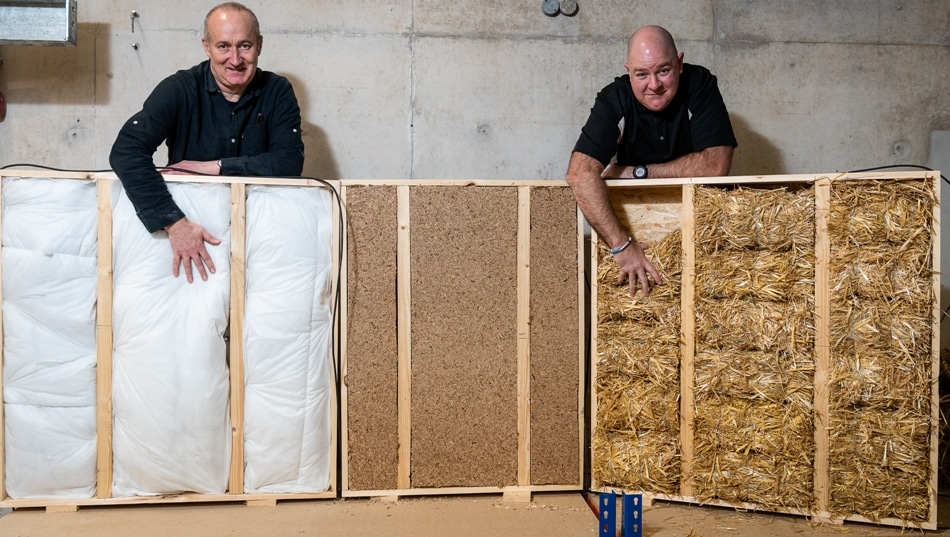Mar 8 2019
A collaborative project between the University of Bath, University of Brighton, UniLaSalle in Rouen (France) and five other academic and non-academic partners, and financed under the Interreg VA France (Channel) England program, is examining the performance of a variety of waste materials and bio-based co-products as substitute building insulation materials.
 Professor Pete Walker (left) and Dr Shawn Platt (right) from the University are Bath are testing a number of waste materials to assess their thermal performance as potential materials for insulating buildings. (Image credit: University of Bath)
Professor Pete Walker (left) and Dr Shawn Platt (right) from the University are Bath are testing a number of waste materials to assess their thermal performance as potential materials for insulating buildings. (Image credit: University of Bath)
Three different materials are being assessed—wheat straw bales, recycled duvets, and rapeseed stalks (processed into bio-composite).
The study team at the University of Bath is experimenting and comparing the thermal performance of the three insulation materials by creating three identical prototype wall panels, each consisting of one of the materials. Their performances will be compared and contrasted with each other as well as against industry standard insulation used presently in plenty of buildings.
The UK Government has given the UK construction sector a target—halving its greenhouse gas emissions by 2025. This has led to the incorporation of technologies capable of building energy-efficient, economical infrastructure and housing.
It is expected that by using already prevailing waste materials or co-products, extensive use of such materials in the construction industry could cause substantial reductions in emissions linked with construction as well as decreasing the reliance on natural resources used in traditional insulation such as rock wool and glass wool.
The panels measure 150 mm in thickness by 1.1 m2 and equipped with 9 mm plywood on either side, similar to how insulation is normally added into buildings. Each panel has several probes measuring interior and exterior temperature, relative humidity, and heat flux.
The panels will be subjected to six weeks of consecutive hard testing in an advanced environmental chamber at the University’s Building Research Park. Two tests will be carried out—a steady state and a non-steady state temperature test.
In the first test, an increasing temperature will be conveyed to one side of the panels to measure the amount of energy necessary to raise the temperature on the other side of the panel. The second test will include increasing the humidity to assess how each material maintains and contains moisture.
This is the first time these materials will have been tested in such a robust scientific way allowing us to accurately assess their thermal performance against each other as well as against industry standard insulation. It is important we continue to play our part in reducing greenhouse gas emissions and the potential to use waste and co-products as potential future alternatives for building insulation, which could significantly help the construction sector become more sustainable and environmentally friendly.
Dr Shawn Platt, Research Associate, Department of Architecture and Civil Engineering, University of Bath.
Our previous research has shown the performance of straw bales as a sustainable and energy efficient building material, however, there are a number of other waste and co-products which could also perform well as construction materials. The opportunity to exploit these waste and agricultural co-products is not something that should be ignored and we are hopeful that if their thermal performance is comparable or better than current insulation, industry will think seriously about using the materials in future construction.
Pete Walker, Professor, Innovative Construction Materials, University of Bath.
The three materials being tested are either bio-based co-products (corn pith and wheat straw panel) or waste (duvets).
In the UK, nearly 7 million tons of straw remains after wheat flour production, and up to half this quantity is effectively cast-off because of its low value, to be used as animal bedding. It is estimated this ‘leftover’ 3.8 million tons of straw could be used to construct more than 500,000 new homes, solving the UK housing scarcity in five years.
Like wheat straw, the performance of straw bales as an energy efficient and sustainable construction material has already been established. In 2015, the first straw eco homes were up for sale Bristol thanks to the University of Bath research.
Duvets are an industrial waste product and it is estimated 61,900 tons of pillows and duvets are sent into the waste stream annually, particularly from hospitals where they are either buried in landfill or basically burned. Also, manufacturing goods such as polyester duvets need energy and discharge greenhouses gases.
Corn pith is the corn stalk’s internal part. The corn stalk is at the moment underused in maize grain crops (50% returned to soil). This agricultural by-product offers a very high potential of valorization for agromaterials. The total estimated possible maize pith resource is 420,000 tons annually in the INTERREG program area.
The University of Bath scientists believe that after completing these demanding tests, they will be able to detect which of the materials is a workable waste material for use in insulating buildings with an aim to commercialize it in the future.